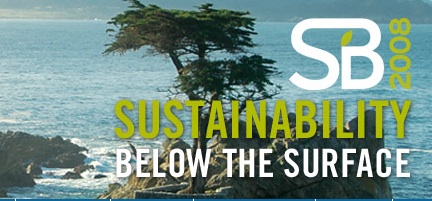With companies and organizations reducing their budgets, there is speculation about what will and what will not survive the cut. Chief Marketing Officers (CMO’s) are expecting that due to the state of the economy, there will be less-emphasis placed on green-marketing over the next year, according to a study conducted by
 year. Marketers are more pessimistic with the state of the business world and want to focus their money and resources on more promising ways to reach consumers. If consumers do not have money to buy essentials, it is reasonable to assume they will not buy products merely to support a cause.
year. Marketers are more pessimistic with the state of the business world and want to focus their money and resources on more promising ways to reach consumers. If consumers do not have money to buy essentials, it is reasonable to assume they will not buy products merely to support a cause. While Apple has taken the approach of incorporating more eco-friendly attributes into the production and manufacturing of their products, brands such as Clorox have attempted to buy sustainability. Clorox has received much scrutiny from Greenpeace in the past, however, Clorox has added the new product line of Greenworks, which uses 99% natural ingredients, as well as purchased the Burt’s Bees brand, in hopes of increasing positive attitudes felt towards the overall brand. Carter Elenz, the executive Vice President of sales and marketing says that as a company they are “still thinking [this market] is expandable” for themselves “and others”. He also makes a strong argument with that, noting that the brand has increased it’s expenditures the highest level it has ever been, and their sales have increased more than 50% in the past year. Bill Morrissey, Vice President of Environmental Stability says that "Clorox is committed to its own journey of environmental stability". From a marketing perspective Clorox has made inventive attempts to reshape their image and to integrate new ideas and brands into their overall business model.
 Overall, whether a company is repositioning their brand as greener or simply buying out already green brands for a more positive company image, green marketing takes a tremendous amount of creativity. Kindley Walsh Lawlor, Gap's (umbrella brand to Old Navy and Banana Republic) director of strategic planning and environmental affairs notes that when using green marketing to re brand, “it’s more of when it’s right for us as a company and when it’s right for the consumers.” Smart marketers have a knack for doing the right thing, at the right time, and targeting the right people. Companies who succeeded in sustainability must use this combination when it comes to green marketing. The consumer not only buys the product, they buy into marketing campaigns and it is essential to keep that at the forefront when creating a sustainable green marketing campaign. Lawlor, among other keynote speakers at the Branding for Sustainability (see above left) workshops, help companies and organizations find the right mix of branding, marketing, green initiatives, and corporate social responsibility to create a sustainable brand.
Overall, whether a company is repositioning their brand as greener or simply buying out already green brands for a more positive company image, green marketing takes a tremendous amount of creativity. Kindley Walsh Lawlor, Gap's (umbrella brand to Old Navy and Banana Republic) director of strategic planning and environmental affairs notes that when using green marketing to re brand, “it’s more of when it’s right for us as a company and when it’s right for the consumers.” Smart marketers have a knack for doing the right thing, at the right time, and targeting the right people. Companies who succeeded in sustainability must use this combination when it comes to green marketing. The consumer not only buys the product, they buy into marketing campaigns and it is essential to keep that at the forefront when creating a sustainable green marketing campaign. Lawlor, among other keynote speakers at the Branding for Sustainability (see above left) workshops, help companies and organizations find the right mix of branding, marketing, green initiatives, and corporate social responsibility to create a sustainable brand.
While this study offers an interesting perspective into what is to come in the next year, we cannot reject that we have undergone a cultural shift towards a greener economy which will continue to effect marketing tactics. While we are experiencing a tighter budget in many facets of life, which will of-course take a toll on marketing strategies, but will not end the age of green. Chief Marketing Strategist Bob Gilbreath argues that cause-marketing “ is still what will get the news” for marketers.

No comments:
Post a Comment